Biology and Psychology: Examining the Interplay of Brain and Behavior
VerifiedAdded on 2022/12/15
|11
|3064
|458
Essay
AI Summary
This essay delves into the principles of biological psychology, exploring the intricate relationship between biology and human behavior. It examines neural communication, the reward system, and the body's stress response, highlighting the roles of key brain structures like the amygdala and hypothalamus. The essay also discusses the connection between sleep and memory consolidation, and explores Alzheimer's disease, detailing its symptoms and neurodegenerative processes. Furthermore, it addresses working memory and attention, referencing studies by Baddeley and Hitch, and Broadbent, respectively, to illustrate how these cognitive functions operate. This assignment provides a comprehensive overview of how biological processes underpin psychological phenomena. Desklib offers a wide array of solved assignments and past papers for students seeking additional resources.
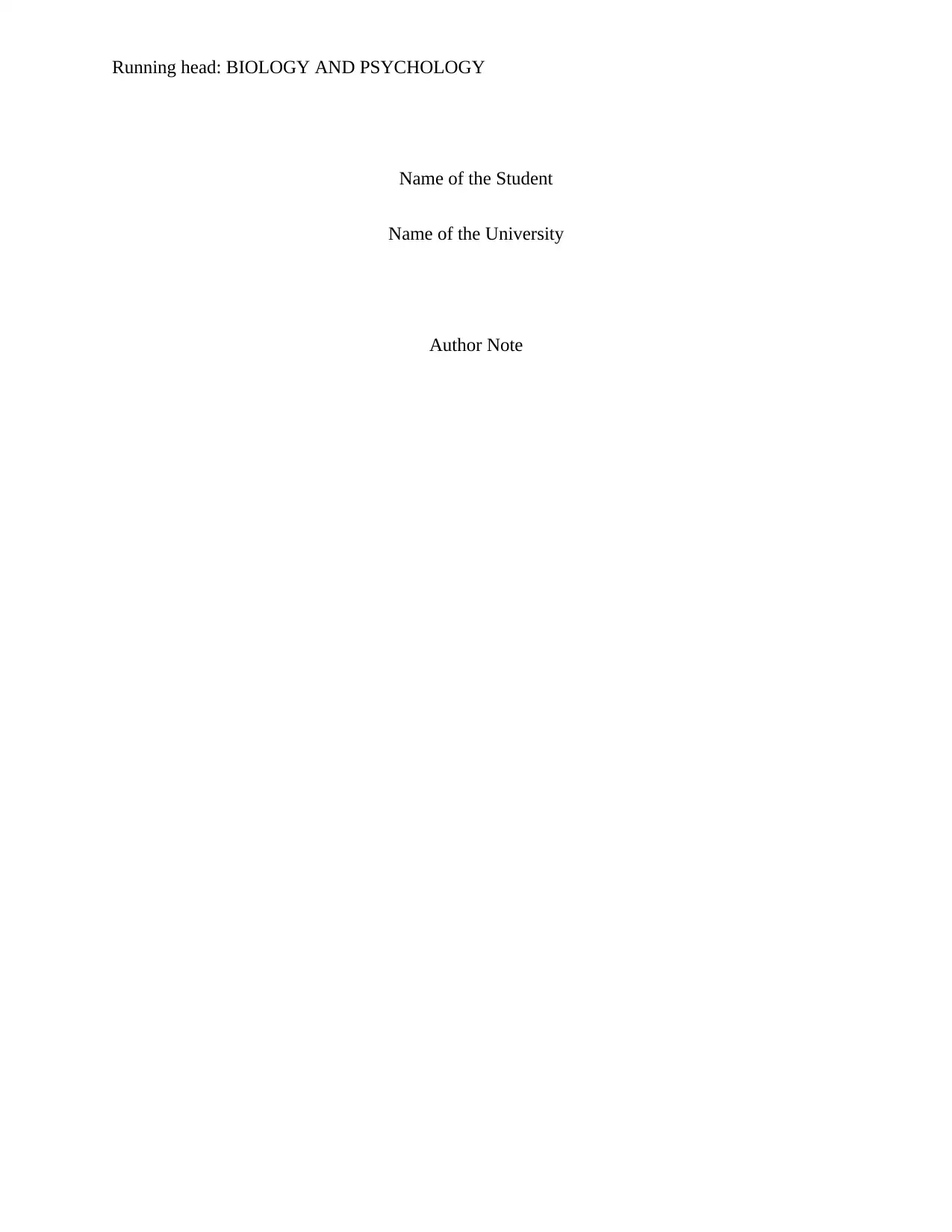
Running head: BIOLOGY AND PSYCHOLOGY
Name of the Student
Name of the University
Author Note
Name of the Student
Name of the University
Author Note
Paraphrase This Document
Need a fresh take? Get an instant paraphrase of this document with our AI Paraphraser
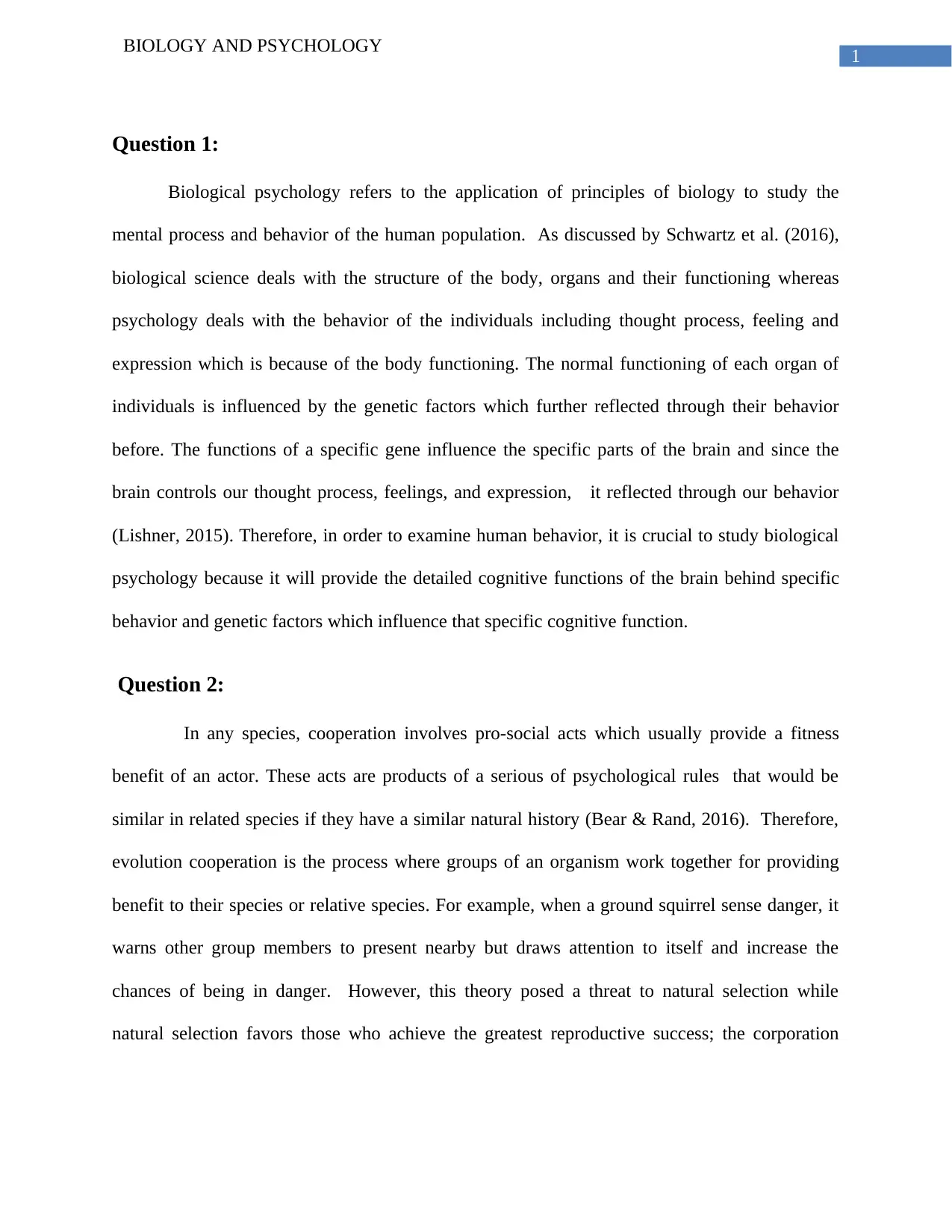
1
BIOLOGY AND PSYCHOLOGY
Question 1:
Biological psychology refers to the application of principles of biology to study the
mental process and behavior of the human population. As discussed by Schwartz et al. (2016),
biological science deals with the structure of the body, organs and their functioning whereas
psychology deals with the behavior of the individuals including thought process, feeling and
expression which is because of the body functioning. The normal functioning of each organ of
individuals is influenced by the genetic factors which further reflected through their behavior
before. The functions of a specific gene influence the specific parts of the brain and since the
brain controls our thought process, feelings, and expression, it reflected through our behavior
(Lishner, 2015). Therefore, in order to examine human behavior, it is crucial to study biological
psychology because it will provide the detailed cognitive functions of the brain behind specific
behavior and genetic factors which influence that specific cognitive function.
Question 2:
In any species, cooperation involves pro-social acts which usually provide a fitness
benefit of an actor. These acts are products of a serious of psychological rules that would be
similar in related species if they have a similar natural history (Bear & Rand, 2016). Therefore,
evolution cooperation is the process where groups of an organism work together for providing
benefit to their species or relative species. For example, when a ground squirrel sense danger, it
warns other group members to present nearby but draws attention to itself and increase the
chances of being in danger. However, this theory posed a threat to natural selection while
natural selection favors those who achieve the greatest reproductive success; the corporation
BIOLOGY AND PSYCHOLOGY
Question 1:
Biological psychology refers to the application of principles of biology to study the
mental process and behavior of the human population. As discussed by Schwartz et al. (2016),
biological science deals with the structure of the body, organs and their functioning whereas
psychology deals with the behavior of the individuals including thought process, feeling and
expression which is because of the body functioning. The normal functioning of each organ of
individuals is influenced by the genetic factors which further reflected through their behavior
before. The functions of a specific gene influence the specific parts of the brain and since the
brain controls our thought process, feelings, and expression, it reflected through our behavior
(Lishner, 2015). Therefore, in order to examine human behavior, it is crucial to study biological
psychology because it will provide the detailed cognitive functions of the brain behind specific
behavior and genetic factors which influence that specific cognitive function.
Question 2:
In any species, cooperation involves pro-social acts which usually provide a fitness
benefit of an actor. These acts are products of a serious of psychological rules that would be
similar in related species if they have a similar natural history (Bear & Rand, 2016). Therefore,
evolution cooperation is the process where groups of an organism work together for providing
benefit to their species or relative species. For example, when a ground squirrel sense danger, it
warns other group members to present nearby but draws attention to itself and increase the
chances of being in danger. However, this theory posed a threat to natural selection while
natural selection favors those who achieve the greatest reproductive success; the corporation
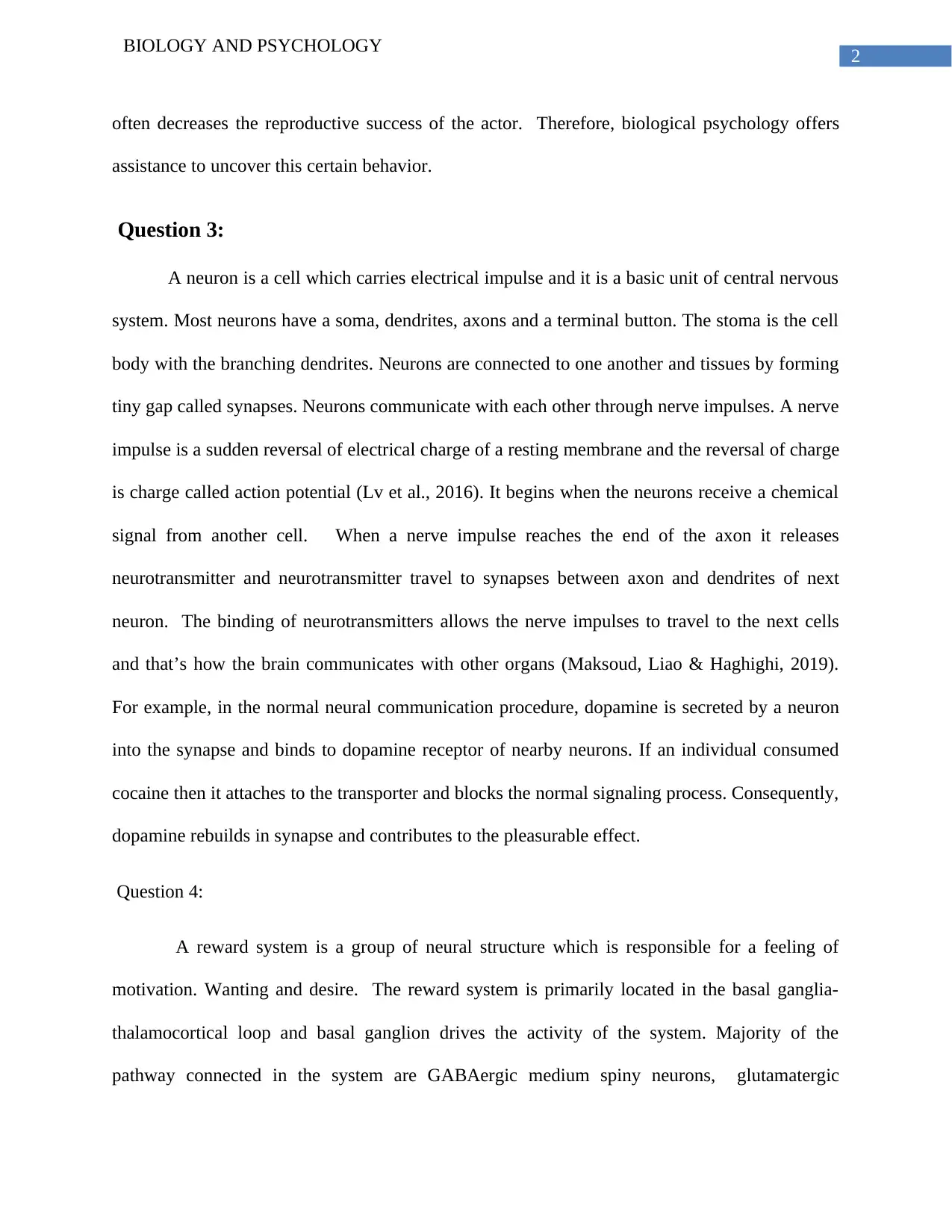
2
BIOLOGY AND PSYCHOLOGY
often decreases the reproductive success of the actor. Therefore, biological psychology offers
assistance to uncover this certain behavior.
Question 3:
A neuron is a cell which carries electrical impulse and it is a basic unit of central nervous
system. Most neurons have a soma, dendrites, axons and a terminal button. The stoma is the cell
body with the branching dendrites. Neurons are connected to one another and tissues by forming
tiny gap called synapses. Neurons communicate with each other through nerve impulses. A nerve
impulse is a sudden reversal of electrical charge of a resting membrane and the reversal of charge
is charge called action potential (Lv et al., 2016). It begins when the neurons receive a chemical
signal from another cell. When a nerve impulse reaches the end of the axon it releases
neurotransmitter and neurotransmitter travel to synapses between axon and dendrites of next
neuron. The binding of neurotransmitters allows the nerve impulses to travel to the next cells
and that’s how the brain communicates with other organs (Maksoud, Liao & Haghighi, 2019).
For example, in the normal neural communication procedure, dopamine is secreted by a neuron
into the synapse and binds to dopamine receptor of nearby neurons. If an individual consumed
cocaine then it attaches to the transporter and blocks the normal signaling process. Consequently,
dopamine rebuilds in synapse and contributes to the pleasurable effect.
Question 4:
A reward system is a group of neural structure which is responsible for a feeling of
motivation. Wanting and desire. The reward system is primarily located in the basal ganglia-
thalamocortical loop and basal ganglion drives the activity of the system. Majority of the
pathway connected in the system are GABAergic medium spiny neurons, glutamatergic
BIOLOGY AND PSYCHOLOGY
often decreases the reproductive success of the actor. Therefore, biological psychology offers
assistance to uncover this certain behavior.
Question 3:
A neuron is a cell which carries electrical impulse and it is a basic unit of central nervous
system. Most neurons have a soma, dendrites, axons and a terminal button. The stoma is the cell
body with the branching dendrites. Neurons are connected to one another and tissues by forming
tiny gap called synapses. Neurons communicate with each other through nerve impulses. A nerve
impulse is a sudden reversal of electrical charge of a resting membrane and the reversal of charge
is charge called action potential (Lv et al., 2016). It begins when the neurons receive a chemical
signal from another cell. When a nerve impulse reaches the end of the axon it releases
neurotransmitter and neurotransmitter travel to synapses between axon and dendrites of next
neuron. The binding of neurotransmitters allows the nerve impulses to travel to the next cells
and that’s how the brain communicates with other organs (Maksoud, Liao & Haghighi, 2019).
For example, in the normal neural communication procedure, dopamine is secreted by a neuron
into the synapse and binds to dopamine receptor of nearby neurons. If an individual consumed
cocaine then it attaches to the transporter and blocks the normal signaling process. Consequently,
dopamine rebuilds in synapse and contributes to the pleasurable effect.
Question 4:
A reward system is a group of neural structure which is responsible for a feeling of
motivation. Wanting and desire. The reward system is primarily located in the basal ganglia-
thalamocortical loop and basal ganglion drives the activity of the system. Majority of the
pathway connected in the system are GABAergic medium spiny neurons, glutamatergic
⊘ This is a preview!⊘
Do you want full access?
Subscribe today to unlock all pages.

Trusted by 1+ million students worldwide
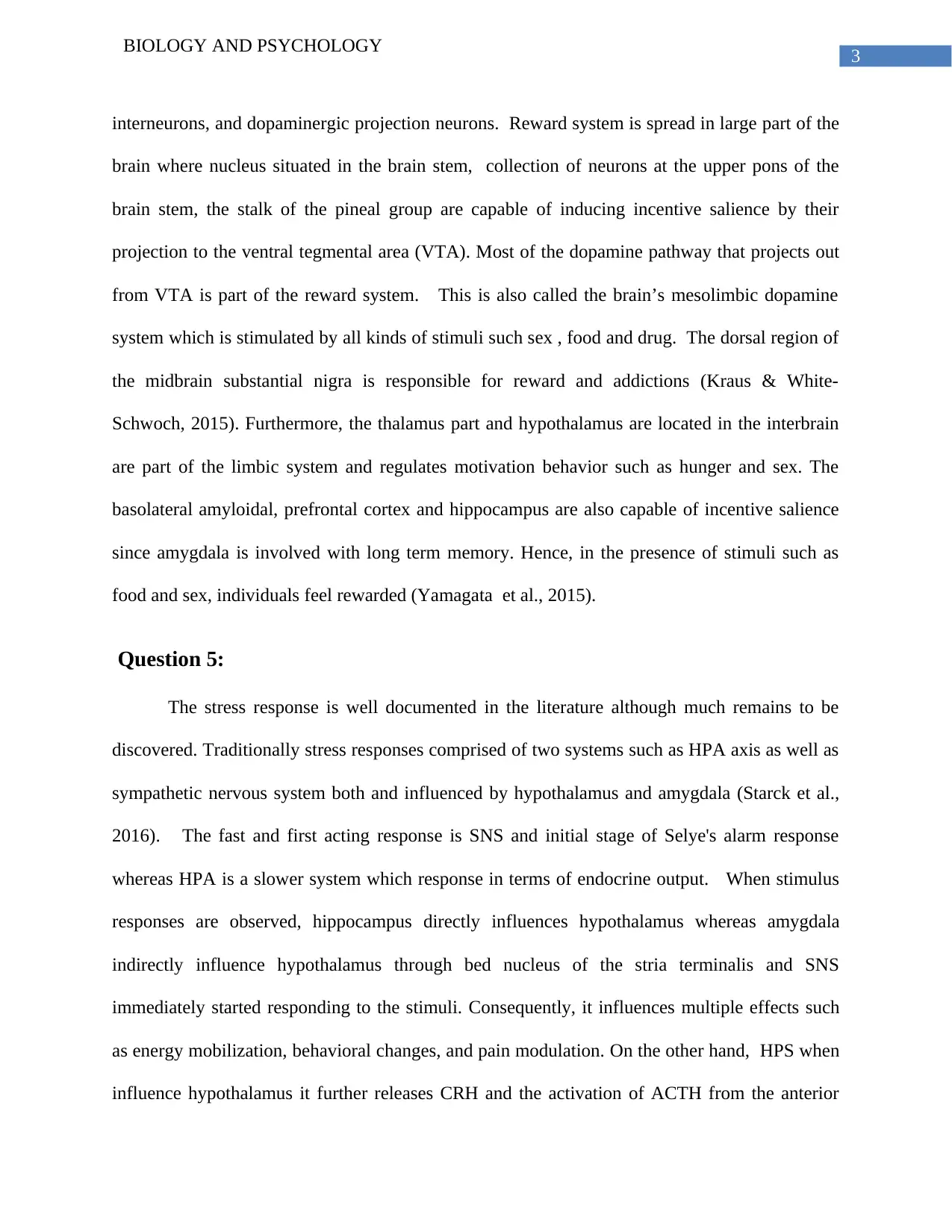
3
BIOLOGY AND PSYCHOLOGY
interneurons, and dopaminergic projection neurons. Reward system is spread in large part of the
brain where nucleus situated in the brain stem, collection of neurons at the upper pons of the
brain stem, the stalk of the pineal group are capable of inducing incentive salience by their
projection to the ventral tegmental area (VTA). Most of the dopamine pathway that projects out
from VTA is part of the reward system. This is also called the brain’s mesolimbic dopamine
system which is stimulated by all kinds of stimuli such sex , food and drug. The dorsal region of
the midbrain substantial nigra is responsible for reward and addictions (Kraus & White-
Schwoch, 2015). Furthermore, the thalamus part and hypothalamus are located in the interbrain
are part of the limbic system and regulates motivation behavior such as hunger and sex. The
basolateral amyloidal, prefrontal cortex and hippocampus are also capable of incentive salience
since amygdala is involved with long term memory. Hence, in the presence of stimuli such as
food and sex, individuals feel rewarded (Yamagata et al., 2015).
Question 5:
The stress response is well documented in the literature although much remains to be
discovered. Traditionally stress responses comprised of two systems such as HPA axis as well as
sympathetic nervous system both and influenced by hypothalamus and amygdala (Starck et al.,
2016). The fast and first acting response is SNS and initial stage of Selye's alarm response
whereas HPA is a slower system which response in terms of endocrine output. When stimulus
responses are observed, hippocampus directly influences hypothalamus whereas amygdala
indirectly influence hypothalamus through bed nucleus of the stria terminalis and SNS
immediately started responding to the stimuli. Consequently, it influences multiple effects such
as energy mobilization, behavioral changes, and pain modulation. On the other hand, HPS when
influence hypothalamus it further releases CRH and the activation of ACTH from the anterior
BIOLOGY AND PSYCHOLOGY
interneurons, and dopaminergic projection neurons. Reward system is spread in large part of the
brain where nucleus situated in the brain stem, collection of neurons at the upper pons of the
brain stem, the stalk of the pineal group are capable of inducing incentive salience by their
projection to the ventral tegmental area (VTA). Most of the dopamine pathway that projects out
from VTA is part of the reward system. This is also called the brain’s mesolimbic dopamine
system which is stimulated by all kinds of stimuli such sex , food and drug. The dorsal region of
the midbrain substantial nigra is responsible for reward and addictions (Kraus & White-
Schwoch, 2015). Furthermore, the thalamus part and hypothalamus are located in the interbrain
are part of the limbic system and regulates motivation behavior such as hunger and sex. The
basolateral amyloidal, prefrontal cortex and hippocampus are also capable of incentive salience
since amygdala is involved with long term memory. Hence, in the presence of stimuli such as
food and sex, individuals feel rewarded (Yamagata et al., 2015).
Question 5:
The stress response is well documented in the literature although much remains to be
discovered. Traditionally stress responses comprised of two systems such as HPA axis as well as
sympathetic nervous system both and influenced by hypothalamus and amygdala (Starck et al.,
2016). The fast and first acting response is SNS and initial stage of Selye's alarm response
whereas HPA is a slower system which response in terms of endocrine output. When stimulus
responses are observed, hippocampus directly influences hypothalamus whereas amygdala
indirectly influence hypothalamus through bed nucleus of the stria terminalis and SNS
immediately started responding to the stimuli. Consequently, it influences multiple effects such
as energy mobilization, behavioral changes, and pain modulation. On the other hand, HPS when
influence hypothalamus it further releases CRH and the activation of ACTH from the anterior
Paraphrase This Document
Need a fresh take? Get an instant paraphrase of this document with our AI Paraphraser
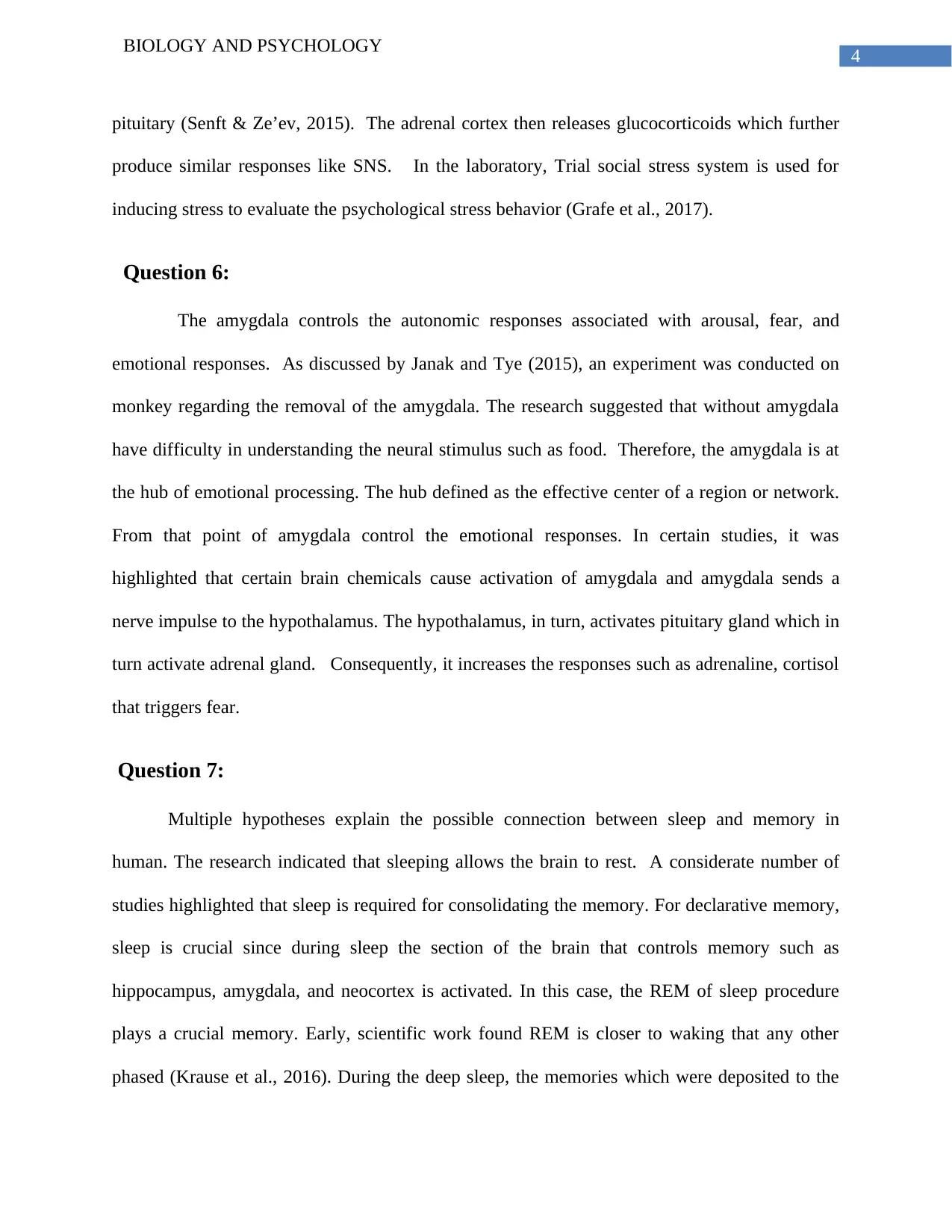
4
BIOLOGY AND PSYCHOLOGY
pituitary (Senft & Ze’ev, 2015). The adrenal cortex then releases glucocorticoids which further
produce similar responses like SNS. In the laboratory, Trial social stress system is used for
inducing stress to evaluate the psychological stress behavior (Grafe et al., 2017).
Question 6:
The amygdala controls the autonomic responses associated with arousal, fear, and
emotional responses. As discussed by Janak and Tye (2015), an experiment was conducted on
monkey regarding the removal of the amygdala. The research suggested that without amygdala
have difficulty in understanding the neural stimulus such as food. Therefore, the amygdala is at
the hub of emotional processing. The hub defined as the effective center of a region or network.
From that point of amygdala control the emotional responses. In certain studies, it was
highlighted that certain brain chemicals cause activation of amygdala and amygdala sends a
nerve impulse to the hypothalamus. The hypothalamus, in turn, activates pituitary gland which in
turn activate adrenal gland. Consequently, it increases the responses such as adrenaline, cortisol
that triggers fear.
Question 7:
Multiple hypotheses explain the possible connection between sleep and memory in
human. The research indicated that sleeping allows the brain to rest. A considerate number of
studies highlighted that sleep is required for consolidating the memory. For declarative memory,
sleep is crucial since during sleep the section of the brain that controls memory such as
hippocampus, amygdala, and neocortex is activated. In this case, the REM of sleep procedure
plays a crucial memory. Early, scientific work found REM is closer to waking that any other
phased (Krause et al., 2016). During the deep sleep, the memories which were deposited to the
BIOLOGY AND PSYCHOLOGY
pituitary (Senft & Ze’ev, 2015). The adrenal cortex then releases glucocorticoids which further
produce similar responses like SNS. In the laboratory, Trial social stress system is used for
inducing stress to evaluate the psychological stress behavior (Grafe et al., 2017).
Question 6:
The amygdala controls the autonomic responses associated with arousal, fear, and
emotional responses. As discussed by Janak and Tye (2015), an experiment was conducted on
monkey regarding the removal of the amygdala. The research suggested that without amygdala
have difficulty in understanding the neural stimulus such as food. Therefore, the amygdala is at
the hub of emotional processing. The hub defined as the effective center of a region or network.
From that point of amygdala control the emotional responses. In certain studies, it was
highlighted that certain brain chemicals cause activation of amygdala and amygdala sends a
nerve impulse to the hypothalamus. The hypothalamus, in turn, activates pituitary gland which in
turn activate adrenal gland. Consequently, it increases the responses such as adrenaline, cortisol
that triggers fear.
Question 7:
Multiple hypotheses explain the possible connection between sleep and memory in
human. The research indicated that sleeping allows the brain to rest. A considerate number of
studies highlighted that sleep is required for consolidating the memory. For declarative memory,
sleep is crucial since during sleep the section of the brain that controls memory such as
hippocampus, amygdala, and neocortex is activated. In this case, the REM of sleep procedure
plays a crucial memory. Early, scientific work found REM is closer to waking that any other
phased (Krause et al., 2016). During the deep sleep, the memories which were deposited to the
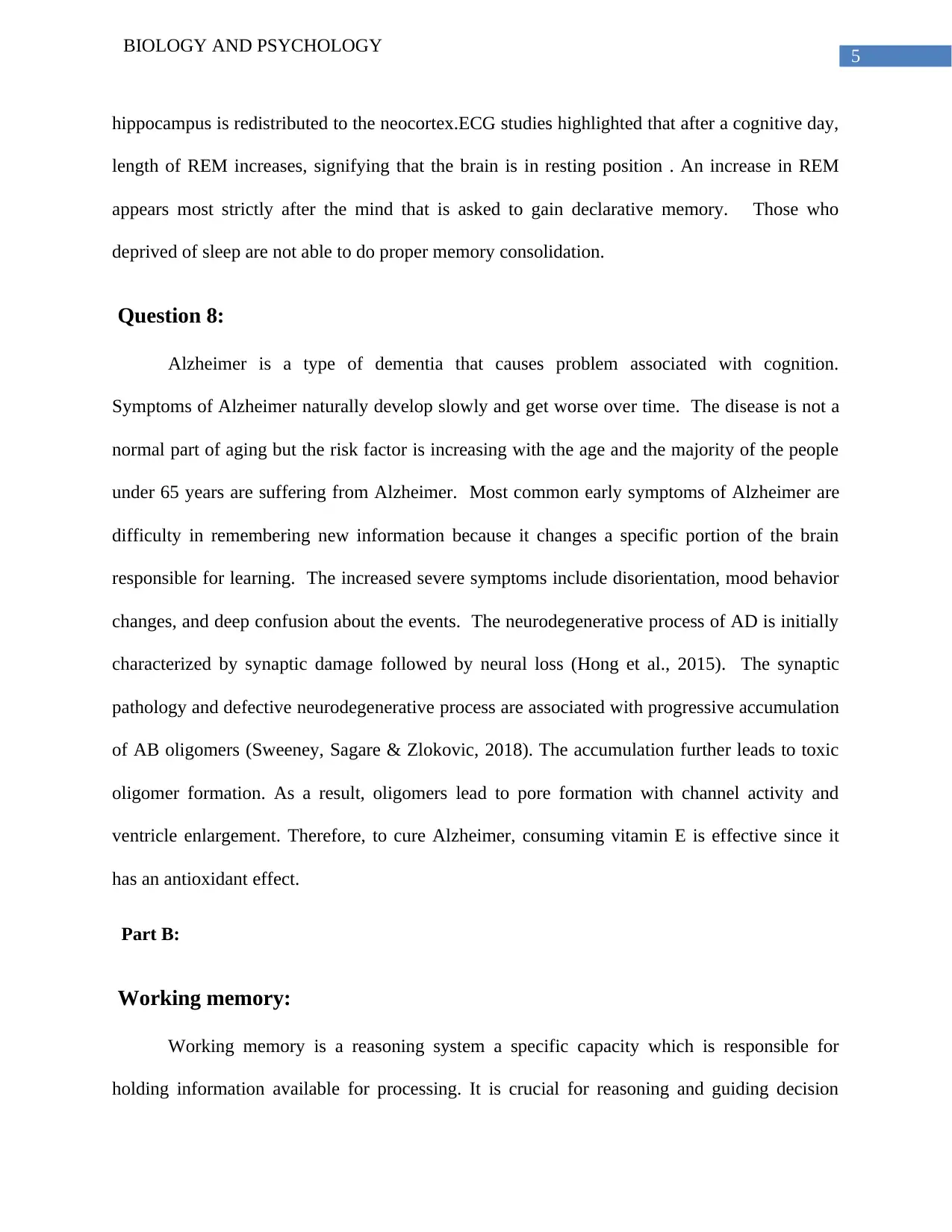
5
BIOLOGY AND PSYCHOLOGY
hippocampus is redistributed to the neocortex.ECG studies highlighted that after a cognitive day,
length of REM increases, signifying that the brain is in resting position . An increase in REM
appears most strictly after the mind that is asked to gain declarative memory. Those who
deprived of sleep are not able to do proper memory consolidation.
Question 8:
Alzheimer is a type of dementia that causes problem associated with cognition.
Symptoms of Alzheimer naturally develop slowly and get worse over time. The disease is not a
normal part of aging but the risk factor is increasing with the age and the majority of the people
under 65 years are suffering from Alzheimer. Most common early symptoms of Alzheimer are
difficulty in remembering new information because it changes a specific portion of the brain
responsible for learning. The increased severe symptoms include disorientation, mood behavior
changes, and deep confusion about the events. The neurodegenerative process of AD is initially
characterized by synaptic damage followed by neural loss (Hong et al., 2015). The synaptic
pathology and defective neurodegenerative process are associated with progressive accumulation
of AB oligomers (Sweeney, Sagare & Zlokovic, 2018). The accumulation further leads to toxic
oligomer formation. As a result, oligomers lead to pore formation with channel activity and
ventricle enlargement. Therefore, to cure Alzheimer, consuming vitamin E is effective since it
has an antioxidant effect.
Part B:
Working memory:
Working memory is a reasoning system a specific capacity which is responsible for
holding information available for processing. It is crucial for reasoning and guiding decision
BIOLOGY AND PSYCHOLOGY
hippocampus is redistributed to the neocortex.ECG studies highlighted that after a cognitive day,
length of REM increases, signifying that the brain is in resting position . An increase in REM
appears most strictly after the mind that is asked to gain declarative memory. Those who
deprived of sleep are not able to do proper memory consolidation.
Question 8:
Alzheimer is a type of dementia that causes problem associated with cognition.
Symptoms of Alzheimer naturally develop slowly and get worse over time. The disease is not a
normal part of aging but the risk factor is increasing with the age and the majority of the people
under 65 years are suffering from Alzheimer. Most common early symptoms of Alzheimer are
difficulty in remembering new information because it changes a specific portion of the brain
responsible for learning. The increased severe symptoms include disorientation, mood behavior
changes, and deep confusion about the events. The neurodegenerative process of AD is initially
characterized by synaptic damage followed by neural loss (Hong et al., 2015). The synaptic
pathology and defective neurodegenerative process are associated with progressive accumulation
of AB oligomers (Sweeney, Sagare & Zlokovic, 2018). The accumulation further leads to toxic
oligomer formation. As a result, oligomers lead to pore formation with channel activity and
ventricle enlargement. Therefore, to cure Alzheimer, consuming vitamin E is effective since it
has an antioxidant effect.
Part B:
Working memory:
Working memory is a reasoning system a specific capacity which is responsible for
holding information available for processing. It is crucial for reasoning and guiding decision
⊘ This is a preview!⊘
Do you want full access?
Subscribe today to unlock all pages.

Trusted by 1+ million students worldwide
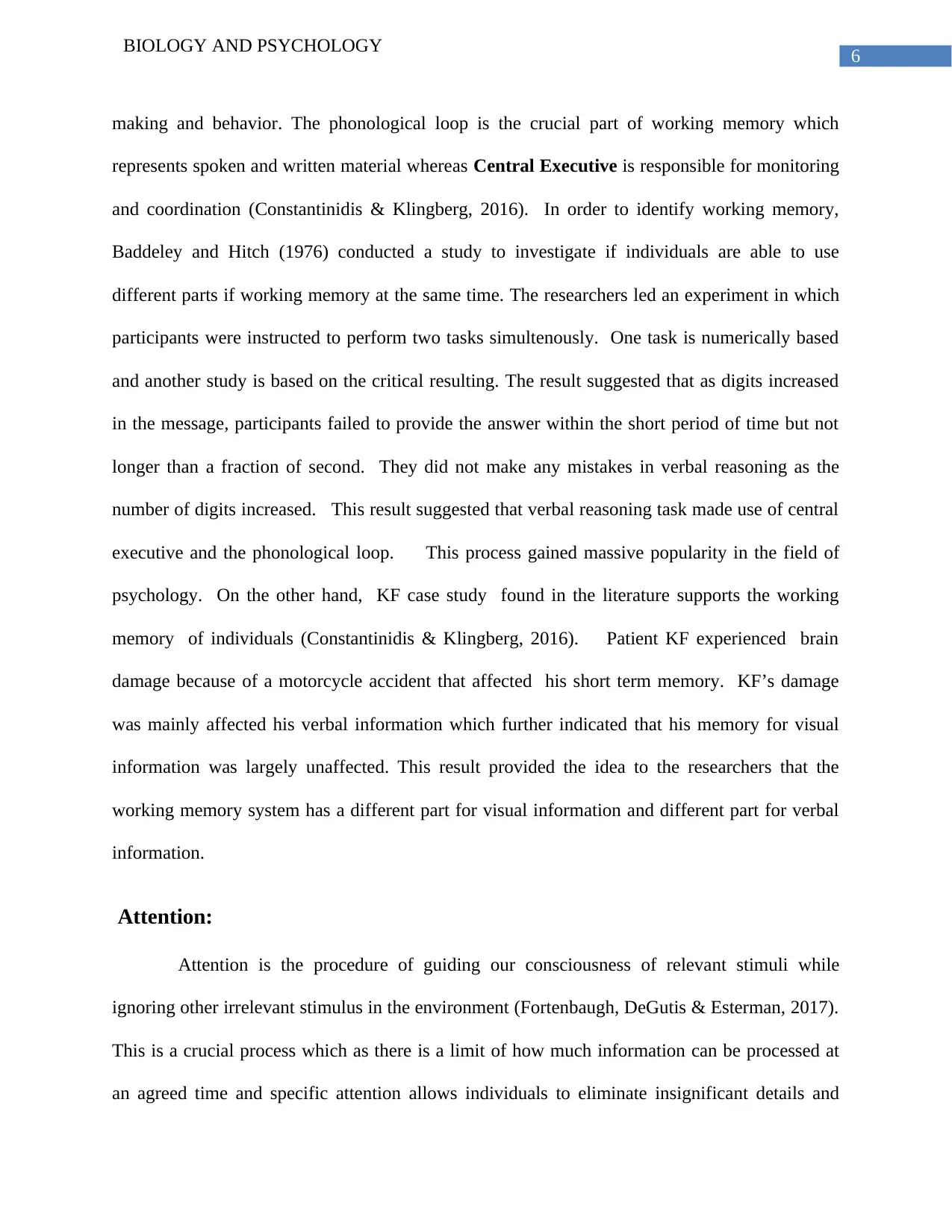
6
BIOLOGY AND PSYCHOLOGY
making and behavior. The phonological loop is the crucial part of working memory which
represents spoken and written material whereas Central Executive is responsible for monitoring
and coordination (Constantinidis & Klingberg, 2016). In order to identify working memory,
Baddeley and Hitch (1976) conducted a study to investigate if individuals are able to use
different parts if working memory at the same time. The researchers led an experiment in which
participants were instructed to perform two tasks simultenously. One task is numerically based
and another study is based on the critical resulting. The result suggested that as digits increased
in the message, participants failed to provide the answer within the short period of time but not
longer than a fraction of second. They did not make any mistakes in verbal reasoning as the
number of digits increased. This result suggested that verbal reasoning task made use of central
executive and the phonological loop. This process gained massive popularity in the field of
psychology. On the other hand, KF case study found in the literature supports the working
memory of individuals (Constantinidis & Klingberg, 2016). Patient KF experienced brain
damage because of a motorcycle accident that affected his short term memory. KF’s damage
was mainly affected his verbal information which further indicated that his memory for visual
information was largely unaffected. This result provided the idea to the researchers that the
working memory system has a different part for visual information and different part for verbal
information.
Attention:
Attention is the procedure of guiding our consciousness of relevant stimuli while
ignoring other irrelevant stimulus in the environment (Fortenbaugh, DeGutis & Esterman, 2017).
This is a crucial process which as there is a limit of how much information can be processed at
an agreed time and specific attention allows individuals to eliminate insignificant details and
BIOLOGY AND PSYCHOLOGY
making and behavior. The phonological loop is the crucial part of working memory which
represents spoken and written material whereas Central Executive is responsible for monitoring
and coordination (Constantinidis & Klingberg, 2016). In order to identify working memory,
Baddeley and Hitch (1976) conducted a study to investigate if individuals are able to use
different parts if working memory at the same time. The researchers led an experiment in which
participants were instructed to perform two tasks simultenously. One task is numerically based
and another study is based on the critical resulting. The result suggested that as digits increased
in the message, participants failed to provide the answer within the short period of time but not
longer than a fraction of second. They did not make any mistakes in verbal reasoning as the
number of digits increased. This result suggested that verbal reasoning task made use of central
executive and the phonological loop. This process gained massive popularity in the field of
psychology. On the other hand, KF case study found in the literature supports the working
memory of individuals (Constantinidis & Klingberg, 2016). Patient KF experienced brain
damage because of a motorcycle accident that affected his short term memory. KF’s damage
was mainly affected his verbal information which further indicated that his memory for visual
information was largely unaffected. This result provided the idea to the researchers that the
working memory system has a different part for visual information and different part for verbal
information.
Attention:
Attention is the procedure of guiding our consciousness of relevant stimuli while
ignoring other irrelevant stimulus in the environment (Fortenbaugh, DeGutis & Esterman, 2017).
This is a crucial process which as there is a limit of how much information can be processed at
an agreed time and specific attention allows individuals to eliminate insignificant details and
Paraphrase This Document
Need a fresh take? Get an instant paraphrase of this document with our AI Paraphraser
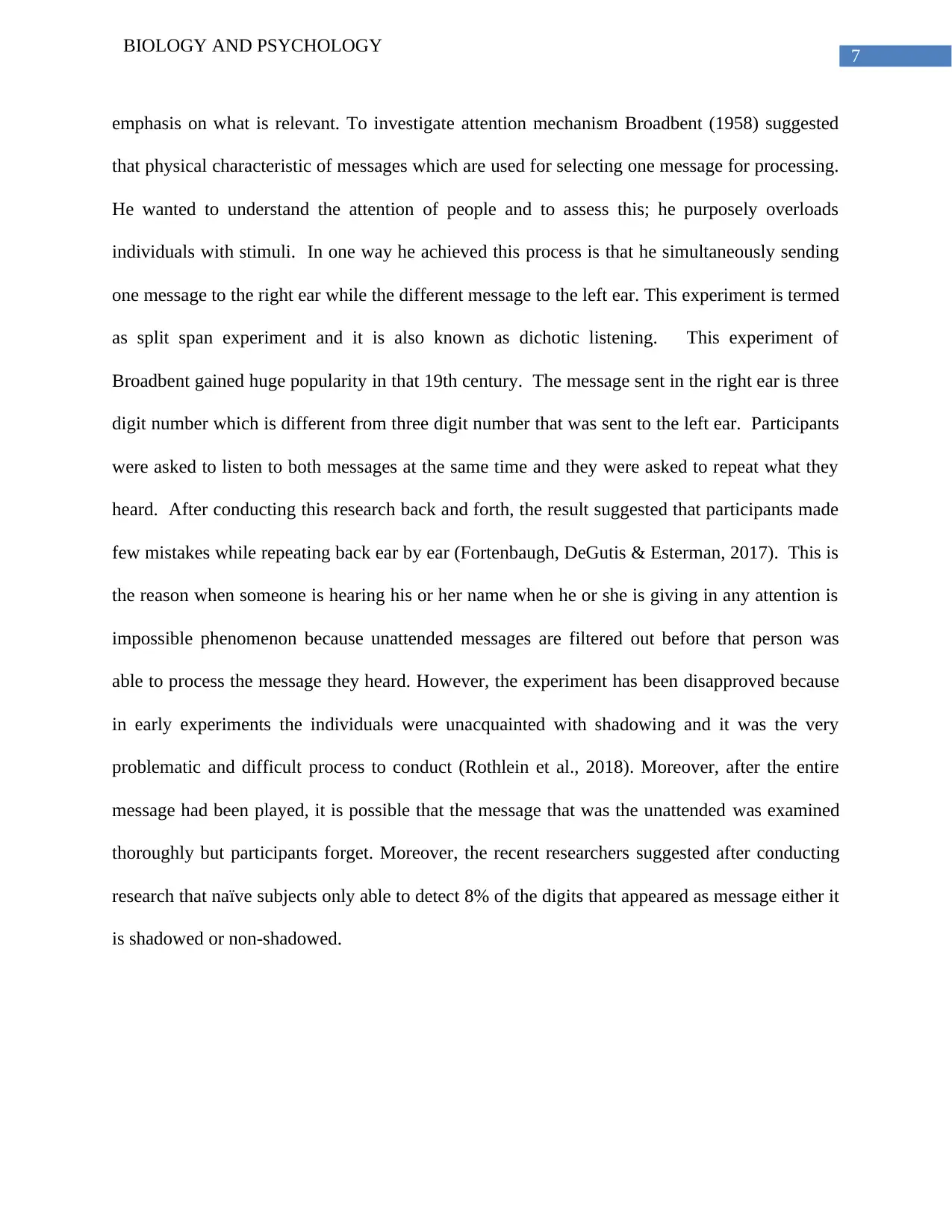
7
BIOLOGY AND PSYCHOLOGY
emphasis on what is relevant. To investigate attention mechanism Broadbent (1958) suggested
that physical characteristic of messages which are used for selecting one message for processing.
He wanted to understand the attention of people and to assess this; he purposely overloads
individuals with stimuli. In one way he achieved this process is that he simultaneously sending
one message to the right ear while the different message to the left ear. This experiment is termed
as split span experiment and it is also known as dichotic listening. This experiment of
Broadbent gained huge popularity in that 19th century. The message sent in the right ear is three
digit number which is different from three digit number that was sent to the left ear. Participants
were asked to listen to both messages at the same time and they were asked to repeat what they
heard. After conducting this research back and forth, the result suggested that participants made
few mistakes while repeating back ear by ear (Fortenbaugh, DeGutis & Esterman, 2017). This is
the reason when someone is hearing his or her name when he or she is giving in any attention is
impossible phenomenon because unattended messages are filtered out before that person was
able to process the message they heard. However, the experiment has been disapproved because
in early experiments the individuals were unacquainted with shadowing and it was the very
problematic and difficult process to conduct (Rothlein et al., 2018). Moreover, after the entire
message had been played, it is possible that the message that was the unattended was examined
thoroughly but participants forget. Moreover, the recent researchers suggested after conducting
research that naïve subjects only able to detect 8% of the digits that appeared as message either it
is shadowed or non-shadowed.
BIOLOGY AND PSYCHOLOGY
emphasis on what is relevant. To investigate attention mechanism Broadbent (1958) suggested
that physical characteristic of messages which are used for selecting one message for processing.
He wanted to understand the attention of people and to assess this; he purposely overloads
individuals with stimuli. In one way he achieved this process is that he simultaneously sending
one message to the right ear while the different message to the left ear. This experiment is termed
as split span experiment and it is also known as dichotic listening. This experiment of
Broadbent gained huge popularity in that 19th century. The message sent in the right ear is three
digit number which is different from three digit number that was sent to the left ear. Participants
were asked to listen to both messages at the same time and they were asked to repeat what they
heard. After conducting this research back and forth, the result suggested that participants made
few mistakes while repeating back ear by ear (Fortenbaugh, DeGutis & Esterman, 2017). This is
the reason when someone is hearing his or her name when he or she is giving in any attention is
impossible phenomenon because unattended messages are filtered out before that person was
able to process the message they heard. However, the experiment has been disapproved because
in early experiments the individuals were unacquainted with shadowing and it was the very
problematic and difficult process to conduct (Rothlein et al., 2018). Moreover, after the entire
message had been played, it is possible that the message that was the unattended was examined
thoroughly but participants forget. Moreover, the recent researchers suggested after conducting
research that naïve subjects only able to detect 8% of the digits that appeared as message either it
is shadowed or non-shadowed.
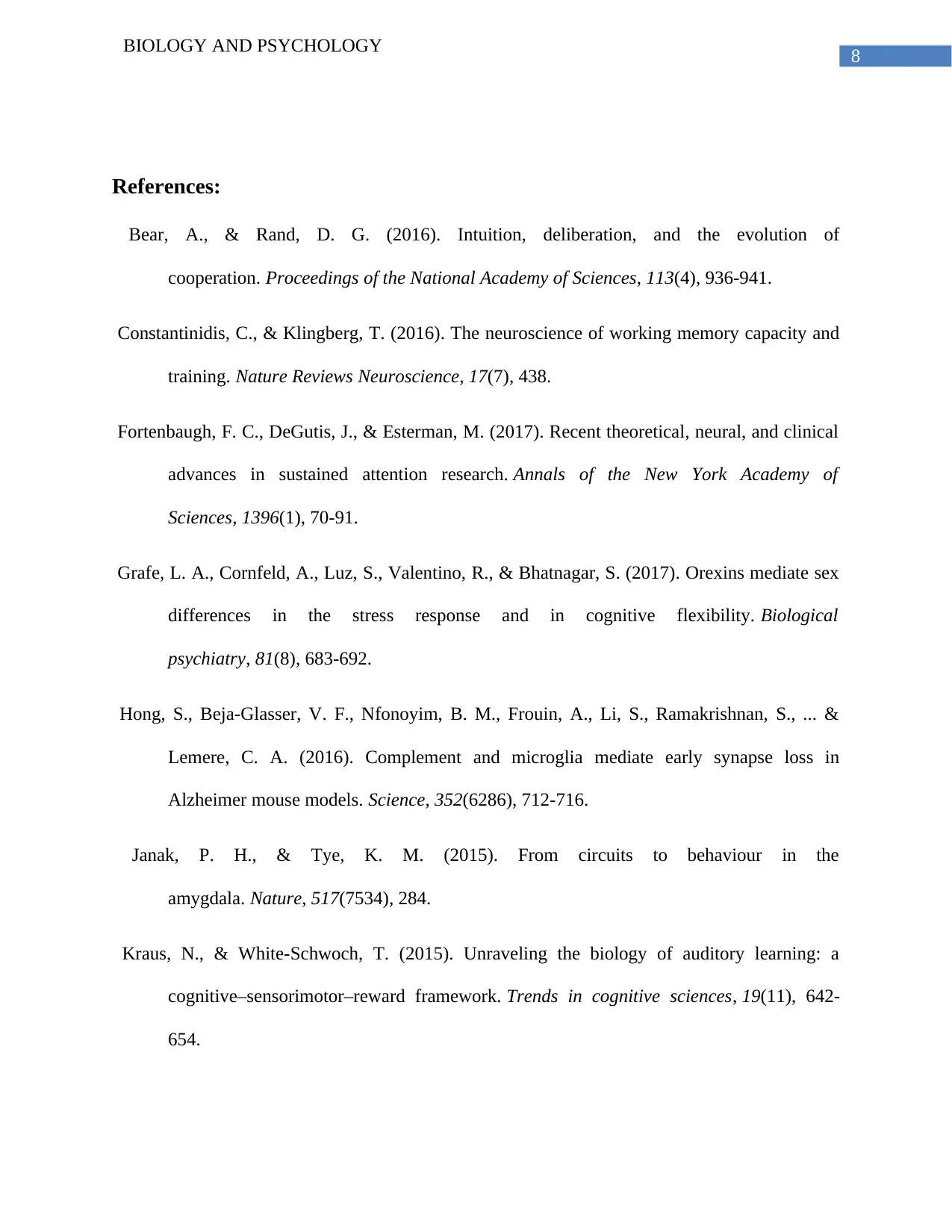
8
BIOLOGY AND PSYCHOLOGY
References:
Bear, A., & Rand, D. G. (2016). Intuition, deliberation, and the evolution of
cooperation. Proceedings of the National Academy of Sciences, 113(4), 936-941.
Constantinidis, C., & Klingberg, T. (2016). The neuroscience of working memory capacity and
training. Nature Reviews Neuroscience, 17(7), 438.
Fortenbaugh, F. C., DeGutis, J., & Esterman, M. (2017). Recent theoretical, neural, and clinical
advances in sustained attention research. Annals of the New York Academy of
Sciences, 1396(1), 70-91.
Grafe, L. A., Cornfeld, A., Luz, S., Valentino, R., & Bhatnagar, S. (2017). Orexins mediate sex
differences in the stress response and in cognitive flexibility. Biological
psychiatry, 81(8), 683-692.
Hong, S., Beja-Glasser, V. F., Nfonoyim, B. M., Frouin, A., Li, S., Ramakrishnan, S., ... &
Lemere, C. A. (2016). Complement and microglia mediate early synapse loss in
Alzheimer mouse models. Science, 352(6286), 712-716.
Janak, P. H., & Tye, K. M. (2015). From circuits to behaviour in the
amygdala. Nature, 517(7534), 284.
Kraus, N., & White-Schwoch, T. (2015). Unraveling the biology of auditory learning: a
cognitive–sensorimotor–reward framework. Trends in cognitive sciences, 19(11), 642-
654.
BIOLOGY AND PSYCHOLOGY
References:
Bear, A., & Rand, D. G. (2016). Intuition, deliberation, and the evolution of
cooperation. Proceedings of the National Academy of Sciences, 113(4), 936-941.
Constantinidis, C., & Klingberg, T. (2016). The neuroscience of working memory capacity and
training. Nature Reviews Neuroscience, 17(7), 438.
Fortenbaugh, F. C., DeGutis, J., & Esterman, M. (2017). Recent theoretical, neural, and clinical
advances in sustained attention research. Annals of the New York Academy of
Sciences, 1396(1), 70-91.
Grafe, L. A., Cornfeld, A., Luz, S., Valentino, R., & Bhatnagar, S. (2017). Orexins mediate sex
differences in the stress response and in cognitive flexibility. Biological
psychiatry, 81(8), 683-692.
Hong, S., Beja-Glasser, V. F., Nfonoyim, B. M., Frouin, A., Li, S., Ramakrishnan, S., ... &
Lemere, C. A. (2016). Complement and microglia mediate early synapse loss in
Alzheimer mouse models. Science, 352(6286), 712-716.
Janak, P. H., & Tye, K. M. (2015). From circuits to behaviour in the
amygdala. Nature, 517(7534), 284.
Kraus, N., & White-Schwoch, T. (2015). Unraveling the biology of auditory learning: a
cognitive–sensorimotor–reward framework. Trends in cognitive sciences, 19(11), 642-
654.
⊘ This is a preview!⊘
Do you want full access?
Subscribe today to unlock all pages.

Trusted by 1+ million students worldwide
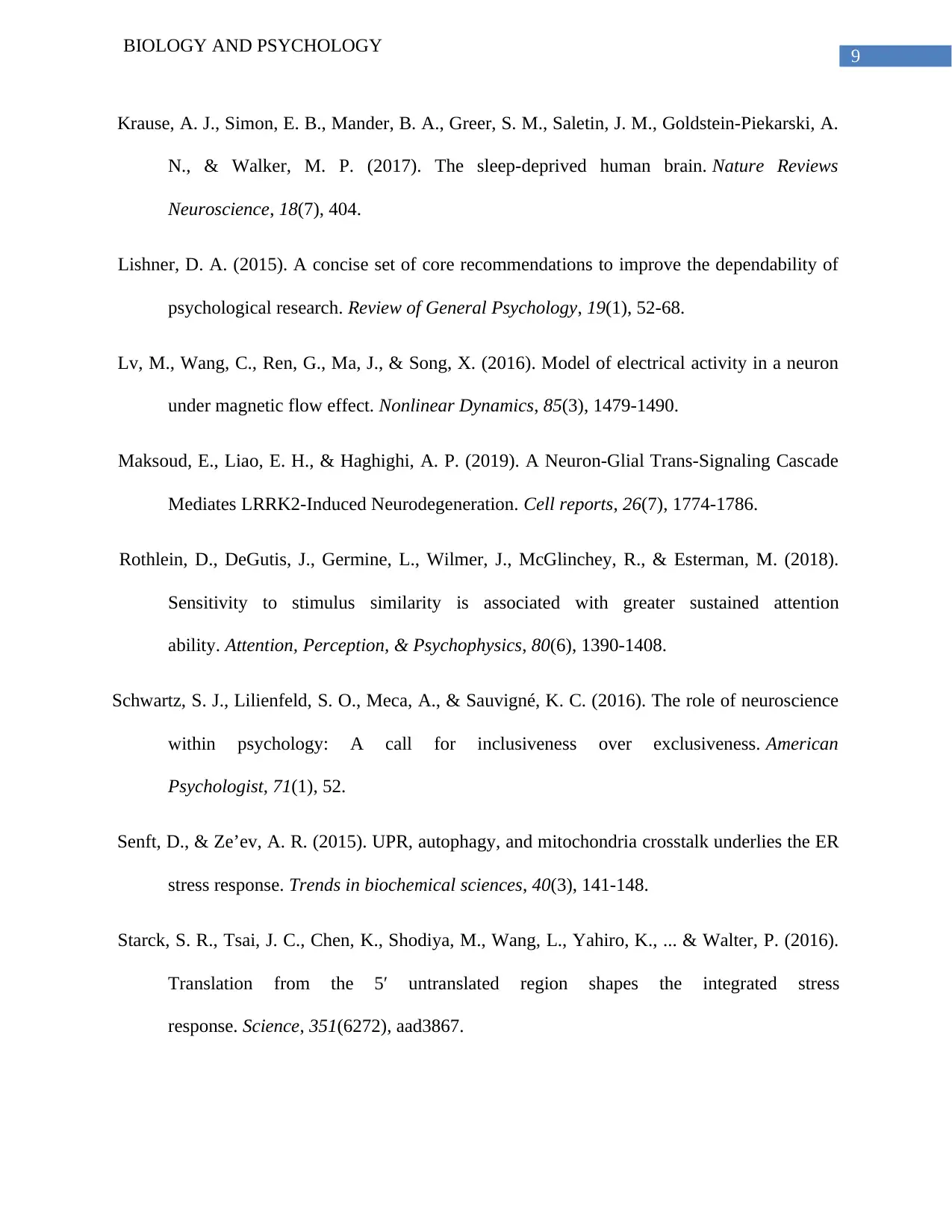
9
BIOLOGY AND PSYCHOLOGY
Krause, A. J., Simon, E. B., Mander, B. A., Greer, S. M., Saletin, J. M., Goldstein-Piekarski, A.
N., & Walker, M. P. (2017). The sleep-deprived human brain. Nature Reviews
Neuroscience, 18(7), 404.
Lishner, D. A. (2015). A concise set of core recommendations to improve the dependability of
psychological research. Review of General Psychology, 19(1), 52-68.
Lv, M., Wang, C., Ren, G., Ma, J., & Song, X. (2016). Model of electrical activity in a neuron
under magnetic flow effect. Nonlinear Dynamics, 85(3), 1479-1490.
Maksoud, E., Liao, E. H., & Haghighi, A. P. (2019). A Neuron-Glial Trans-Signaling Cascade
Mediates LRRK2-Induced Neurodegeneration. Cell reports, 26(7), 1774-1786.
Rothlein, D., DeGutis, J., Germine, L., Wilmer, J., McGlinchey, R., & Esterman, M. (2018).
Sensitivity to stimulus similarity is associated with greater sustained attention
ability. Attention, Perception, & Psychophysics, 80(6), 1390-1408.
Schwartz, S. J., Lilienfeld, S. O., Meca, A., & Sauvigné, K. C. (2016). The role of neuroscience
within psychology: A call for inclusiveness over exclusiveness. American
Psychologist, 71(1), 52.
Senft, D., & Ze’ev, A. R. (2015). UPR, autophagy, and mitochondria crosstalk underlies the ER
stress response. Trends in biochemical sciences, 40(3), 141-148.
Starck, S. R., Tsai, J. C., Chen, K., Shodiya, M., Wang, L., Yahiro, K., ... & Walter, P. (2016).
Translation from the 5′ untranslated region shapes the integrated stress
response. Science, 351(6272), aad3867.
BIOLOGY AND PSYCHOLOGY
Krause, A. J., Simon, E. B., Mander, B. A., Greer, S. M., Saletin, J. M., Goldstein-Piekarski, A.
N., & Walker, M. P. (2017). The sleep-deprived human brain. Nature Reviews
Neuroscience, 18(7), 404.
Lishner, D. A. (2015). A concise set of core recommendations to improve the dependability of
psychological research. Review of General Psychology, 19(1), 52-68.
Lv, M., Wang, C., Ren, G., Ma, J., & Song, X. (2016). Model of electrical activity in a neuron
under magnetic flow effect. Nonlinear Dynamics, 85(3), 1479-1490.
Maksoud, E., Liao, E. H., & Haghighi, A. P. (2019). A Neuron-Glial Trans-Signaling Cascade
Mediates LRRK2-Induced Neurodegeneration. Cell reports, 26(7), 1774-1786.
Rothlein, D., DeGutis, J., Germine, L., Wilmer, J., McGlinchey, R., & Esterman, M. (2018).
Sensitivity to stimulus similarity is associated with greater sustained attention
ability. Attention, Perception, & Psychophysics, 80(6), 1390-1408.
Schwartz, S. J., Lilienfeld, S. O., Meca, A., & Sauvigné, K. C. (2016). The role of neuroscience
within psychology: A call for inclusiveness over exclusiveness. American
Psychologist, 71(1), 52.
Senft, D., & Ze’ev, A. R. (2015). UPR, autophagy, and mitochondria crosstalk underlies the ER
stress response. Trends in biochemical sciences, 40(3), 141-148.
Starck, S. R., Tsai, J. C., Chen, K., Shodiya, M., Wang, L., Yahiro, K., ... & Walter, P. (2016).
Translation from the 5′ untranslated region shapes the integrated stress
response. Science, 351(6272), aad3867.
Paraphrase This Document
Need a fresh take? Get an instant paraphrase of this document with our AI Paraphraser
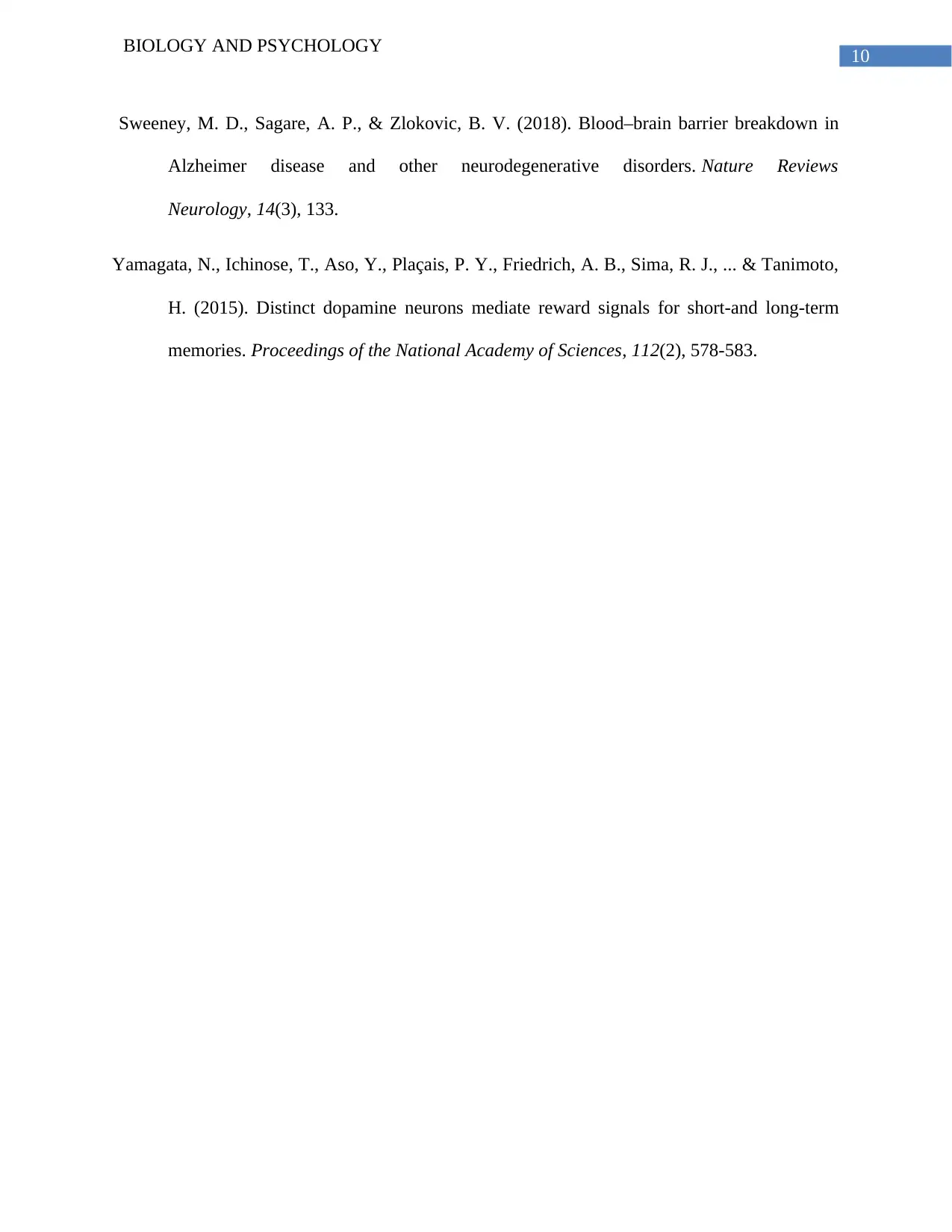
10
BIOLOGY AND PSYCHOLOGY
Sweeney, M. D., Sagare, A. P., & Zlokovic, B. V. (2018). Blood–brain barrier breakdown in
Alzheimer disease and other neurodegenerative disorders. Nature Reviews
Neurology, 14(3), 133.
Yamagata, N., Ichinose, T., Aso, Y., Plaçais, P. Y., Friedrich, A. B., Sima, R. J., ... & Tanimoto,
H. (2015). Distinct dopamine neurons mediate reward signals for short-and long-term
memories. Proceedings of the National Academy of Sciences, 112(2), 578-583.
BIOLOGY AND PSYCHOLOGY
Sweeney, M. D., Sagare, A. P., & Zlokovic, B. V. (2018). Blood–brain barrier breakdown in
Alzheimer disease and other neurodegenerative disorders. Nature Reviews
Neurology, 14(3), 133.
Yamagata, N., Ichinose, T., Aso, Y., Plaçais, P. Y., Friedrich, A. B., Sima, R. J., ... & Tanimoto,
H. (2015). Distinct dopamine neurons mediate reward signals for short-and long-term
memories. Proceedings of the National Academy of Sciences, 112(2), 578-583.
1 out of 11
Related Documents
Your All-in-One AI-Powered Toolkit for Academic Success.
+13062052269
info@desklib.com
Available 24*7 on WhatsApp / Email
![[object Object]](/_next/static/media/star-bottom.7253800d.svg)
Unlock your academic potential
Copyright © 2020–2025 A2Z Services. All Rights Reserved. Developed and managed by ZUCOL.



